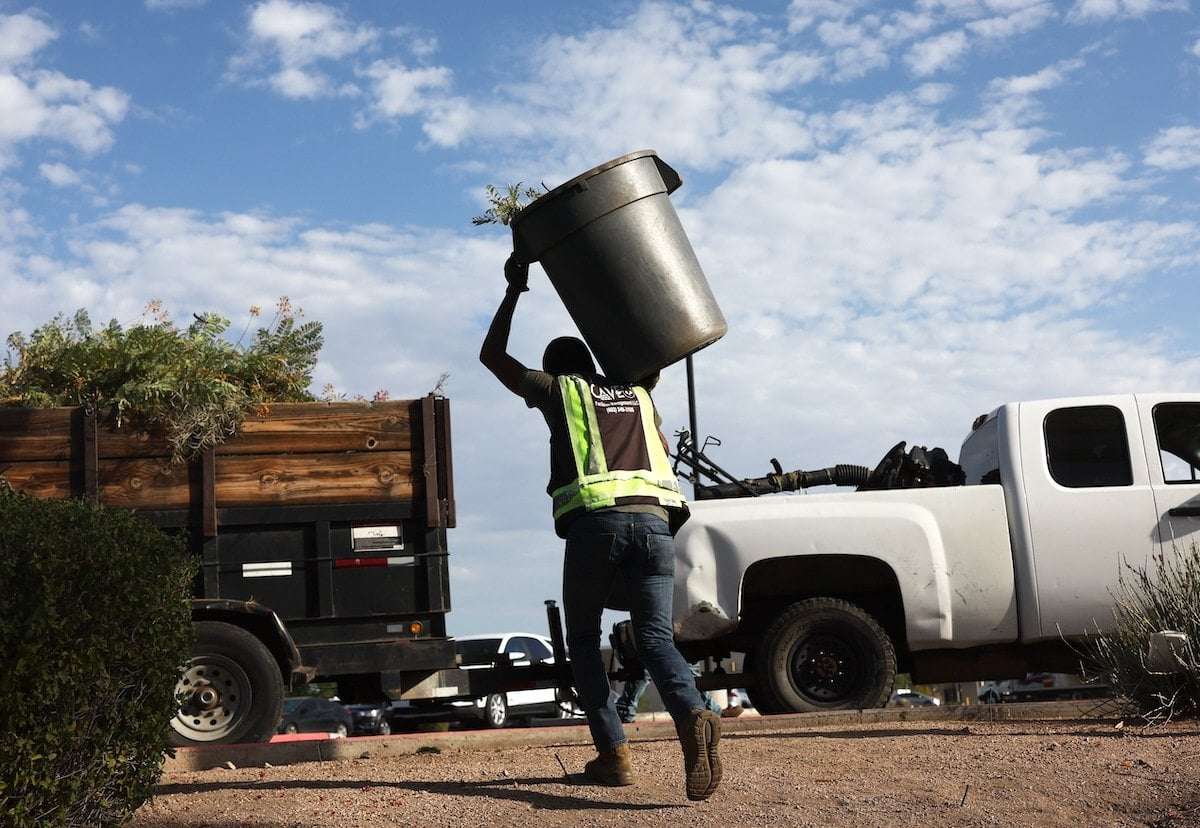Founded in 2005 as an Ohio-based environmental newspaper, EcoWatch is a digital platform dedicated to publishing quality, science-based content on environmental issues, causes, and solutions.
A historic new law in Phoenix, Arizona, will provide thousands of outdoor workers in the hottest city in the country with protections from extreme heat.
In a unanimous vote, the Phoenix City Council passed an ordinance requiring that workers have easy access to rest, potable water and shade, as well as training to recognize signs of heat stress, a press release from the National Council for Occupational Safety and Health (National COSH) said. Vehicles with enclosed cabs must also have access to air conditioning.
“People who work outside and in hot indoor environments in Phoenix suffer unacceptably during our deadly summers, with too few protections,” said Katelyn Parady, a Phoenix-based expert on worker health and safety with National COSH, who assisted unions and local workers in advocating for the new extreme heat protection measures, in a press release from National COSH. “This ordinance is a critical first step toward getting workers lifesaving protections and holding employers accountable for safety during heat season. It’s also a model for how local governments can leverage their contracts to protect the workers who keep their communities running from climate change dangers.”
In 2023, there were a record 31 consecutive days of 110-plus degree heat in Phoenix. The city had 340 deaths related to the extreme heat, with 645 in Maricopa County, according to the county health department. Three-quarters of the heat-related fatalities happened outdoors.
In the United States, more than 40 percent of outdoor workers are Hispanic or Black, while making up approximately 32 percent of the population, reported The Guardian.
People of color and low-income workers are the most impacted by the hazards of extreme heat. According to Public Citizen, the risk of Latinx workers dying from heat stress is more than three times higher than that of their peers.
“This heat safety ordinance will change my life,” said Filiberto Lares, who has been delivering food to airplanes for Sky Chefs at the Phoenix Sky Harbor airport for 11 years, as The Guardian reported.
The new ordinance will apply to outdoor laborers who work for city contractors and subcontractors of engineering, construction and airport projects, as well as other city services, the press release said.
“The heat at Sky Harbor Airport is dangerous and all of us who work there know it,” said passenger service agent Cecilia Ortiz, who filed a complaint against her employer last summer over the sweltering conditions, in the press release. “We’re glad the city of Phoenix is stepping up to require that airlines and their contractors give us basic heat protections outdoors and in the jet bridges. Now we need to keep pushing to make sure cabin cleaners, who work inside planes but often with the A/C off, are also protected. And we are going to hold our employers accountable. They must take this ordinance seriously, so we can stay safe at work.”
In addition to the safety requirements required of contractors, they will also have to create and keep a heat safety plan.
“In the summers, when the temperatures reach extremes, the asphalt on the tarmac is even hotter,” said Lares, who is a UNITE HERE Local 11 member in Phoenix, in the press release. “It has felt as though people forget that many of us work in vehicles. Having air conditioning in work trucks, buses, and delivery vans matters just as much as in a building because those vehicles are our workplaces.”
Lori Bays, Phoenix’s deputy manager, said the new rule would apply to roughly 10,000 city contract workers, reported The Guardian.
“Phoenix is recognizing the need to take action to protect the most vulnerable,” said Juan Declet-Barreto, a climate vulnerability researcher with the Union of Concerned Scientists, as The Guardian reported. “With an intense heat island effect, there’s very little vegetation and an unequal distribution of shading and trees that can help lower exposure to temperatures.”
As climate change continues to bring increasingly hotter summers to Phoenix, advocates of the ordinance say broader protections are necessary for all workers, not only those employed by the city’s contractors and subcontractors, the press release said.
“It’s good news that our city council is listening to workers who are in grave danger due to climate change,” Parady said in the press release. “But your body’s ability to cope with extreme heat does not depend on whether you work for a city contractor, directly for the city or for a private employer. We’re going to keep organizing until all workers have strong protection from heat – because everyone works under the same blazing sun.”

daveashaw on April 2nd, 2024 at 14:30 UTC »
I have been to Tuscon once, during July in 1995.
It was 108F in the shade--I cannot fathom working outside in those conditions.
Literally lethal.
Chris4477 on April 2nd, 2024 at 13:13 UTC »
It’s nice to see any progress on paper, but it’s also unfortunate that a lot of it ends up being lip-service when you’re actually out on the job
QueenBeeeeeeee on April 2nd, 2024 at 13:03 UTC »
It’s sad that this even has to go through to be passed. It should be a basic human right to have protection from heat while working. Especially in Arizona where it can be triple digits